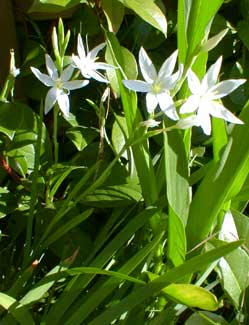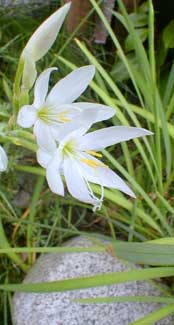
White Form
Kaffir Lily
Hesperantha coccinea forma alba, the "Pure White" or "White Form Kaffir Lily," is also known as White Cape Lily, White River Lily, White Berg Lily, or Winter Ixia. The quest for a name other than "Kaffir" is strongest in South Africa itself, where the word has been used in a derogatory manner by white Afrikaaners against aboriginal peoples, but in Great Britain & North America the word has no such meaning.
The word Kaffir originally had no racial meaning at all. Muslim peoples of any race used the Arabic word to mean "Infidel," & anyone who converted to Islam immediately ceased to be a kaffir. To Moslems even today, all Hindus & Christians are alike Kaffirs. The literal meaning would be "does not embrace the truth (of Islam)," & by extension it means "Liar." So it did always have a negative connotation akin to Christian assessment of non-Christians as "Heathens," but it was not racial.
 In Africa per se the word spread first among unconvewrted East African aboriginal peoples, who even took to calling themselves collectively kafulcr because their own varied languages had no shared single word for tribal peoples in total, & this Arabic borrowing filled a void. When the Boers or Dutch warred for control of Zulu land in South Africa, the term finally took on racist connotations.
In Africa per se the word spread first among unconvewrted East African aboriginal peoples, who even took to calling themselves collectively kafulcr because their own varied languages had no shared single word for tribal peoples in total, & this Arabic borrowing filled a void. When the Boers or Dutch warred for control of Zulu land in South Africa, the term finally took on racist connotations.To great extent, then, calling this plant Kaffir Lily is a bit like calling Brazil Nuts "Nigger Toes," a common name that has pretty much fallen from usage as unnecessarily offending. As a Kaffir in North America is exclusively the flower, it has no derogatory meaning, & is apt to remain the best known common name for them. But whenever vacationing in South Africa, it would be wise to get Kaffir Lily out of one's vocabulary & call them Cape Lilies or River Lilies, or by the Bantu name Khahlana. Just don't expect anyone in North America to know Kaffir Lilies by any other name!
The natural wild form of this flower, native of South Africa, Lesotho, & Swaziland, is bright red. There are many cultivated colors not found in the wild. Pure white "Alba" however is a naturally occurring variant.
It's starry white blooms appear as early as August & persist (with deadheading) well into Febuary in our temperate autumns & winters, with unexpected reblooms the rest of spring & in summer. The first photo on this page was taken in August (2001); the second is from October (2003)
It has an everblooming capacity for all four seasons in Western Washington which won't be duplicated in all climates. It is generally regarded as primarily an autumn bloomer.
The gleaming whiteness is particularly striking as an autumn/winter bloomer because it provides a spot of considerable brightness for gloomy autumn dusks.
Our "Pure White" is a large grassy patch which grows along with "Mrs. Hegarty's" Pink River Lily, which is the palest most delicate shade of pink.
Every three to four years our scattered clumps of river lilies will need to be dug up & divided, or the plant will tire & cease to bloom at the center. If this is not done the blades of lily-grass may darken & die after several years, but when refreshed by division it remains the healthiest of evergreens forgiving of almost all conditions except extended dryness.
Hesperantha coccinea 'Mrs. Hegarty'